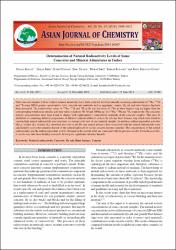| dc.contributor.author | Baltaş, Hasan | |
| dc.contributor.author | Kiriş, Erkan | |
| dc.contributor.author | Ustabaş, İlker | |
| dc.contributor.author | Yılmaz, Esra | |
| dc.contributor.author | Şirin, Murat | |
| dc.contributor.author | Kuloğlu, Emrah | |
| dc.contributor.author | Güneş, Banu Erdoğan | |
| dc.date.accessioned | 2020-12-19T20:03:07Z | |
| dc.date.available | 2020-12-19T20:03:07Z | |
| dc.date.issued | 2014 | |
| dc.identifier.citation | Baltas, H., Kiris, E., Ustabas, I., Yilmaz, E., Sirin, M., Kuloglu, M., Gunes, B.E., (2014).Determination of Natural Radioactivity Levels of Some Concretes and Mineral Admixtures in Turkey.Asian Journal of Chemistry, 26(13), 3946-3952.https://doi.org/10.14233/ajchem.2014.16045 | |
| dc.identifier.issn | 0970-7077 | |
| dc.identifier.issn | 0975-427X | |
| dc.identifier.uri | https://doi.org/10.14233/ajchem.2014.16045 | |
| dc.identifier.uri | https://hdl.handle.net/11436/3095 | |
| dc.description | Sirin, Murat/0000-0001-6864-752X | en_US |
| dc.description | WOS: 000343763700041 | en_US |
| dc.description.abstract | Nine concrete samples with or without mineral admixtures have been analyzed for their naturally occurring radionuclide of Ra-226, Th-232 and K-40 using HPGe gamma spectrometry. Also, concrete raw materials such as aggregate, cement, fly ash and blast furnace slag have been measured. the radioactivity values of Ra-226, Th-232 and K-40 in fly ash and those of Ra-226 in blast furnace slag are higher than the corresponding world mean specific activities values which are 50, 50 and 500 Bq kg(-1) for Ra-226, Th-232 and K-40, respectively. the concretes activity concentrations have been found to change with supplementary cementitious materials of the concrete samples. This may be attributed to containing different proportions of different mineral additives such as fly ash and blast furnace slag which were found to contain high natural radionuclide concentrations according to the rest of raw material samples. in addition, radium equivalent activities (Ra-eq), gamma-index (I-gamma), alpha-index (I alpha), absorbed dose rate in air (D) and annual effective dose associated with the natural radionuclide were calculated to assess the radiation hazard of the natural radioactivity in the concrete mixture samples. the concentration of the natural radionuclides and the radium equivalent activity obtained in the present study are compared with the previous results. From these results, it can be seen that these building materials do not pose significant radiation hazards. | en_US |
| dc.language.iso | eng | en_US |
| dc.publisher | Asian Journal of Chemistry | en_US |
| dc.rights | info:eu-repo/semantics/openAccess | en_US |
| dc.subject | Natural radioactivity | en_US |
| dc.subject | Concrete | en_US |
| dc.subject | Fly ash | en_US |
| dc.subject | Blast furnace | en_US |
| dc.subject | Cement | en_US |
| dc.title | Determination of natural radioactivity levels of some concretes and mineral admixtures in Turkey | en_US |
| dc.type | article | en_US |
| dc.contributor.department | RTEÜ, Fen - Edebiyat Fakültesi, Fizik Bölümü | en_US |
| dc.contributor.institutionauthor | Baltaş, Hasan | |
| dc.contributor.institutionauthor | Kiriş, Erkan | |
| dc.contributor.institutionauthor | Ustabaş, İlker | |
| dc.contributor.institutionauthor | Yılmaz, Esra | |
| dc.contributor.institutionauthor | Şirin, Murat | |
| dc.contributor.institutionauthor | Kuloğlu, Emrah | |
| dc.contributor.institutionauthor | Güneş, Banu Erdoğan | |
| dc.identifier.doi | 10.14233/ajchem.2014.16045 | |
| dc.identifier.volume | 26 | en_US |
| dc.identifier.issue | 13 | en_US |
| dc.identifier.startpage | 3946 | en_US |
| dc.identifier.endpage | 3952 | en_US |
| dc.ri.edit | oa | en_US |
| dc.relation.journal | Asian Journal of Chemistry | en_US |
| dc.relation.publicationcategory | Makale - Uluslararası Hakemli Dergi - Kurum Öğretim Elemanı | en_US |


















